A dog paw pad injury can run the gamut from burns to cuts or punctures. To help you know what to do if your dog has a hurt paw pad, integrative veterinarian Dr. Julie Buzby describes the types of paw pad injuries. Plus, she gives step-by-step first aid instructions on what to do for paw pad injuries and explains when to call the vet.
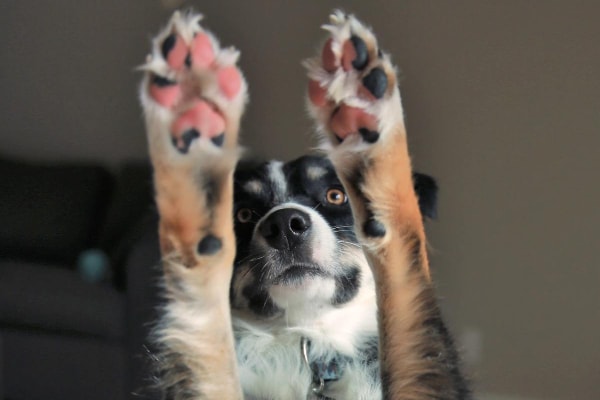
Recently, one of my clients brought her Labrador Retriever, April, to see me for a paw pad injury.
When April started limping during her daily walk, her mom discovered that April had stepped on a sliver of broken glass. Thankfully, my client had previously taken classes about “doggie first aid,” so she was well prepared. She gently removed the sliver of glass from April’s paw. And then she cleaned and bandaged the paw and made an appointment with me.
As I examined April’s injured paw, I commended her mom on a job well done. The paw looked great and the bandaging job was excellent. Her first aid classes had definitely paid off.
Not all dog parents may have had the chance to take a course like that though, so I wanted to write this article to provide guidance about recognizing and treating paw pad injuries. But before we get to that, let’s start with some paw pad basics.
Why are a dog’s paw pads important?
Have you ever heard the saying “put your best foot forward”? Usually, this refers to entering a new challenge or situation with a good attitude. But literally “putting their best foot forward” is also important for our dogs.
What I mean to say is that your dog’s paws play a big role in his or her well-being. The muscles, bones, tendons, and ligaments help your dog walk, run, or play. And doing so comfortably and securely is made possible in part by your dog’s paw pads.
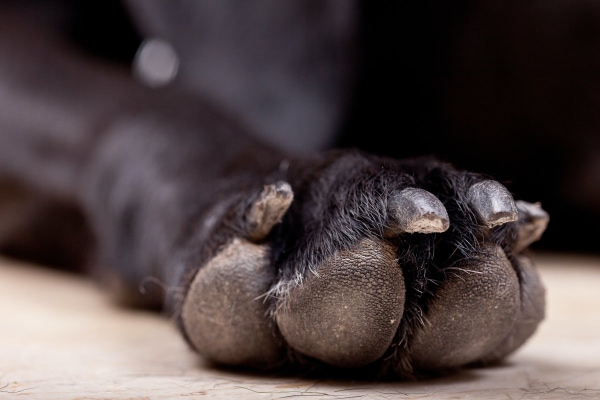
These thick, squishy foot pads provide cushioning and absorb impact every step your dog takes. This reduces the strain on the bones and joints of your dog’s foot.
Plus, in combination with the toenails, the foot pads provide traction as your dog walks. And they help him or her navigate rough terrain. Last, but certainly not least, the paw pads protect your dog from extreme temperatures.
(To learn more about the amazing anatomy of your dog’s paw, check out my article on dog paw anatomy.)
What are some types of paw pad injuries in dogs?
The paw pads are in constant contact with the ground and are exposed to many elements that can cause wear and tear. This opens them up to a variety of injuries including:
Foreign bodies
One of the more common foot injuries I see in my patients is a foreign object puncturing the paw pad. Various sharp objects such as broken glass, foxtails in dogs, nails, sticks, fishing hooks, and more can become embedded in the paw pad.
Cuts
If a sharp object doesn’t get lodged in the pad, it could cause a cut instead. Paw pad cuts are another common injury since one of the pad’s jobs is to protect the rest of the foot from coming into contact with dangerous objects. These cuts often happen when a dog slices a foot on something sharp. However, dogs can also get non-traumatic cuts if they have dry paw pads that crack and split open.
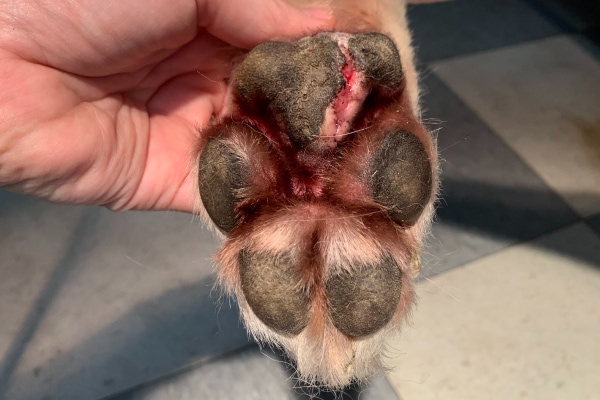
Flaps
Paw pad flaps are very similar to cuts but tend to cover more surface area on the paw since they run roughly parallel to the surface of the paw pad. Typically, a flap will occur when something slices the dog’s foot horizontally.
For example, if your dog’s foot becomes tangled in sharp wire or metal, it might partially shave off a section of the paw pad. This creates a loose flap of skin. Flaps can also happen if a cut is left untreated. As the cut becomes larger, eventually the tissue may tear, forming a flap.
Sometimes the flap hangs down from the foot, but other times it partially folds back over the exposed tissue. Generally speaking, flaps are more painful than cuts. Each step your dog takes pulls on the loose skin and irritates the flap.
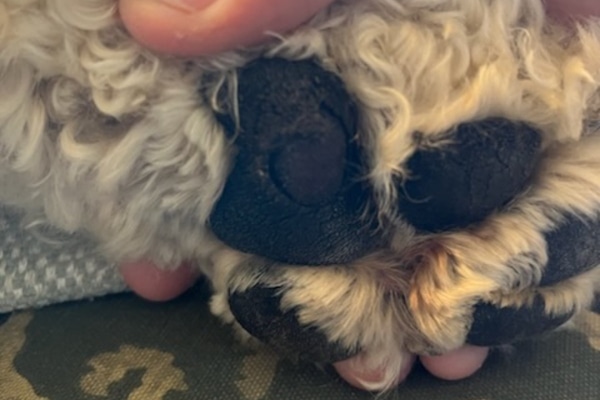
Burns
Unfortunately, I see a lot of pad burns in my patients too. These usually occur in the summer months as the sun heats up the asphalt, concrete, artificial turf, or other surfaces. Even on a seemingly pleasant 86°F day, the pavement can be a blistering 135°F. Unsurprisingly then, when your dog walks on hot pavement, it can physically burn his or her paw pads.
On the other hand, extremely cold temperatures, like walking on ice for a prolonged period of time, can also burn your dog’s paws. And walking on ice melt products can cause your dog’s paws to become dry, cracked, or burnt too.
Finally, walking through spilled caustic substances can cause chemical burns on your dog’s feet. And spending a long time running over abrasive surfaces like tennis courts can also burn your dog’s paw pads.
Ingrown toenails
Sometimes overly long nails can begin to curl toward the paw pad. If the nail gets long enough and has no where else to go, it may create a penetrating wound in the pad.
Not only are ingrown toenails extremely painful for your dog, but they can also cause a paw pad infection by trapping dirt and bacteria in the wound.
This is one of the many reasons why I believe trimming your dog’s toenails monthly is so important. If you aren’t comfortable doing them yourself, check out my Nail Trimming Master Course or reach out to your veterinarian for help.
What are the signs of a paw pad injury?
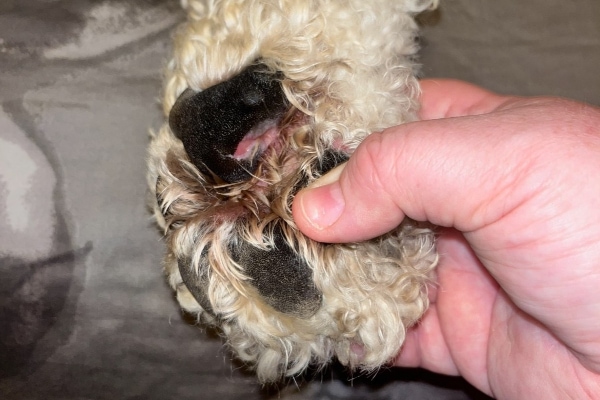
If your dog experiences any of the paw pad injuries listed above, there are several symptoms you might notice:
- Sudden lameness (your dog is limping)
- Crying out when putting weight on the affected paw
- Being unwilling to put pressure on the paw
- Bleeding from the paw pad
- Licking or biting at the paw
- Swelling of the foot
- Discoloration or reddening of the paw pad
- Visible cut, flap, puncture, or object in the paw pad
- Discoloration of the hair on the foot
If you notice any of these symptoms, carefully inspect your dog’s paw. Depending on what you find, there may be some helpful first aid measures you can take until you can get your dog to the veterinarian.
First aid for paw pad injuries
To get a better idea of what is going on with your dog’s paw, and to learn what to do for your dog’s paw pad injury, follow these steps:
1. Evaluate your dog as a whole
Comfort your dog and assess his or her attitude. If your dog is severely painful, you may not be able to safely look at his or her foot by yourself. Even the nicest and most well-behaved dog can react negatively when in pain.
If your dog does not want you messing with the injured paw, please seek veterinary care rather than attempting to follow the rest of the steps.
2. Take a closer look at the paw
If you feel it is safe to look at your dog’s paw, carefully inspect the top and bottom, the paw pads themselves, and the area between the toes and paw pads. It is important to know if your dog has a cut, flap, puncture wound, burn on the paw pad, if your dog ripped a nail off, or if there is no visible injury.
Depending on the problem and injury, you might need to provide different types of first aid care. The following steps are specific to paw pad injuries…
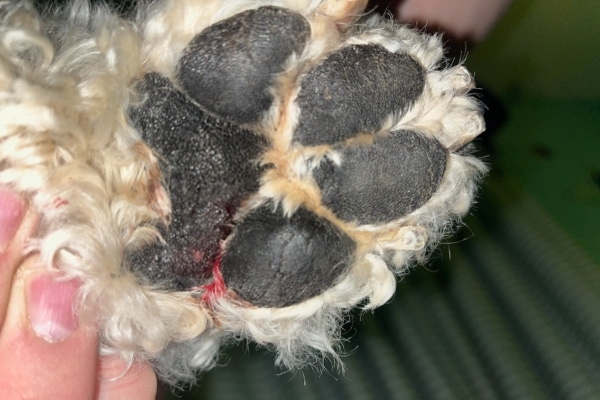
If there is an object in the paw pad, go to step 3a. Otherwise, proceed to step 3b for a bleeding wound or step 4 for a burn or non-bleeding wound.
3. Remove foreign objects (if present and safe to remove) and apply pressure to stop the bleeding
3a. If your dog has a small or superficial object puncturing the paw pad, you may be able to remove it with your fingers or tweezers. But if the object is deeply lodged or possibly puncturing a blood vessel, nerve, or joint, do not remove it yourself. Instead, make an emergency vet visit.
3b. If the wound is actively bleeding, apply pressure evenly with a clean cloth or paper towel. Minor wounds should stop bleeding within a minute or two. But, if the cut keeps steadily bleeding for 10 to 15 minutes, you should contact your vet immediately. This could be an emergency.
4. Clean the wound
Once the bleeding has stopped, it is a good idea to clean the wound. I recommend doing so with cool water because it can help reduce swelling and ease pain, especially if your dog is suffering from a burn. You can also use gentle anti-bacterial soap, or disinfecting agents like chlorohexidine or betadine, to help remove bacteria and prevent an infection.
Remember that as you clean the wound, it might start bleeding a little again. If this happens, gently apply pressure until the bleeding stops.
5. Apply a bandage
In order to keep the wound clean and safe from further injury, you might need to bandage your dog’s foot. (Or if you don’t have bandaging materials, wrapping a clean towel or T-shirt around a bleeding wound while you make your way to the vet will also work in a pinch.) When applying the bandage, it is important to use clean materials like gauze and vet wrap. For detailed instructions, please read my article about how to wrap a dog’s paw.
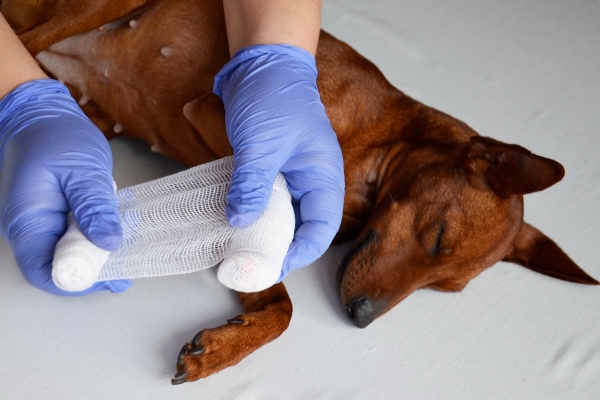
Remember that a bandage that is too tight is far worse than no bandage at all. Please ensure that you can insert one to two fingers into the top of the bandage. If not, it is probably too tight. Also, watch for signs that the bandage is cutting off your dog’s circulation. Signs to look for include swollen toes (if sticking out of the bandage) or a foot that is cool to the touch or discolored.
6. Contact your veterinarian
Even though you provided first aid for your dog’s paw, it is important to follow up with your vet to see if any additional steps are necessary.
While waiting for the veterinary appointment (if one is needed), check and change the bandage daily. This allows you to monitor the wound for changes or signs of infection. And regular bandage changes also decrease the risk that the bandage is restricting your dogs circulation.
How will the veterinarian evaluate a dog’s paw pad injury?
During the appointment, your veterinarian will start by performing a physical exam on your dog. Although the main problem is your dog’s paw pad injury, the vet will probably want to do a full body exam to ensure your dog doesn’t have any other injuries.
Then, while examining the foot, he or she will look for cuts, punctures, burns, or other injuries. Plus, he or she will likely palpate and manipulate the bones and joints of the foot to check for issues with those structures.
If your vet suspects there is an object (like a foxtail or metal nail) deep in the foot, he or she may also recommend an X-ray. This can be a good way to help determine if the wound involves the bones or joints. Plus, especially with a metal object, the X-ray helps the vet assess the position and location of the foreign body.
How does the vet treat a paw pad injury?
Depending on the location of the dog pad injury, the vet may want to trim the hair on the affected foot. This will allow better visualization of the dog foot pad injury and helps keep the wound clean. Then your vet will clean the wound and remove any debris or foreign objects.
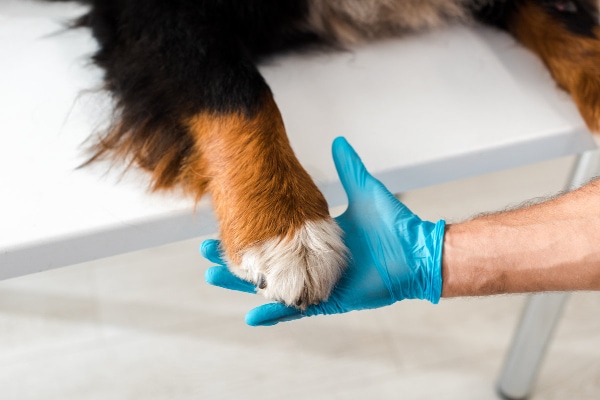
If your dog has a cut or flap, your veterinarian will probably not suture the pad closed. I know this may seem odd because usually getting a deep cut equals needing stitches.
The paw pads are a bit different from other areas on your dog’s body, though. They don’t usually hold stitches very well. Because they encounter so much friction and movement, the sutures can easily be torn out. And in many cases, suturing the pad does not speed up healing time.
However, bandaging the foot can be very helpful. If there is a cut or burn, your veterinarian might apply an antibacterial ointment or soothing cream to promote healing and decrease pain. Next, he or she will apply a bandage. This bandage serves many purposes:
- Controlling bleeding
- Decreasing the chances of re-injury
- Keeping the wound clean
- Containing the medication that is applied
- Preventing your dog from licking or chewing on the wound (but sometimes the dog needs an E-collar too)
As your veterinarian is applying the bandage, be sure to listen carefully to the instructions. He or she will direct you regarding how often to change the bandage, what materials and medications to use, and if you need to bring your dog back in for rechecks.
Be patient and stay in contact with your vet
As your vet will probably explain, paw pad injuries can take time to heal since your dog is constantly using the foot. Remember to be patient with the process. Follow your vet’s instructions and contact your vet if you suspect your dog’s injury isn’t healing well.
(And keep in mind that, as discussed earlier, it is important that you don’t place the bandage too tight. Foot and toe swelling from a too-tight bandage is one of the most common complications I see with paw pad injuries.)
How do I prevent future foot pad injuries?
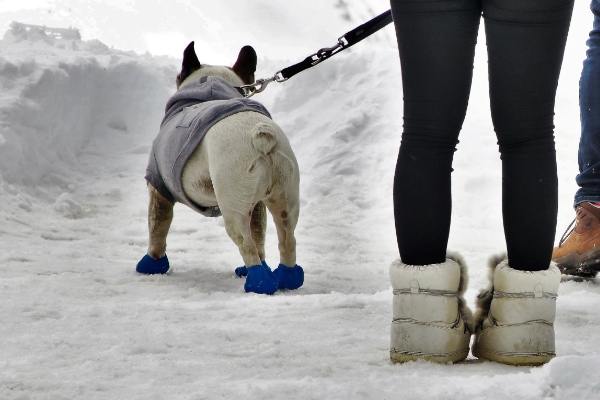
While sometimes an injury is unavoidable, there are a few precautions you can take to prevent paw injuries. They include:
- Avoid exposing your dog’s feet to extreme temperatures. This may mean timing your walk so that it isn’t in the heat of the day (which also helps avoid heat stroke in dogs) or revising your route so your dog isn’t walking on hot sidewalks. Remember that if you can’t comfortably hold the back of your hand against the pavement for 7-10 seconds, it is too hot for your dog to walk on.
- Consider protective dog booties like PawZ dog boots. These rubber boots are thin enough to allow your dog to sense the ground while also providing protection against ice melt products or extreme temperatures. They can also be great for keeping a bandage clean and dry while outside. (As a word of warning, remove the PawZ boots once you come inside. They could compromise your dog’s circulation if left on too long).
- Wash your dog’s feet off after winter walks to remove any ice melt products (and do the same if you suspect your dog walked through any other chemicals).
- Try out thicker dog boots or socks to protect your dog’s feet if walking where there could be sharp rocks, trash, or other dangers. Be warned, though, that these types of dog boots tend to make it harder for dogs to sense where their feet are (i.e. proprioception in dogs), so they aren’t my favorite products.
- Carefully inspect your dog’s feet (and whole body) for foxtails after every trip outside if you live or visit somewhere where foxtails are a problem.
- Regularly trim your dog’s nails to keep them from growing into the pad.
- Keep your eyes open for hazards along the path or trail.
You can provide paw pad injury first aid for your dog
While all of these prevention strategies are helpful, I also want to remind you of the importance of being prepared for possible injuries ahead of time. If you don’t already have a dog first aid kit, now is a great time to make one for your house and one for your car or backpack. You never know when you might need it!
Hopefully, your dog doesn’t ever get a paw pad injury. But if he or she does, remain calm, grab your first aid kit, and follow the steps I outlined for you in this article.
I believe that you can provide first aid to your dog. But when in doubt, remember to contact your veterinarian for advice. He or she can help you manage your dog’s pad injury so that your pup can be back to playing in no time!
Has your dog ever had a paw pad injury?
Please comment below.


My medium size Labradodle has a dime size piece of the marcopial peeled off.. It is still black, like a really dark gray. No blood or pink patches. The other paws have a little bit of peeling. We had a family party and he was running around our pool surrounded by pavers. Running like he had the zoomies and then swimming with guests. That evening he was limping and we discovered the injuries. We cleaned, and applied Neosporin, and then bandaged. we also put booties on, He has been in my lap all day, only get up and greeting my son with his usual excitement.
I’m concerned because he hasn’t urinated all day, Even when we carried him outside.
He’s been drinking water.
Why isn’t he urinating.?
Is it ok to have bandages on all day? I read the paws need to breath and release sweat.
Thank you for this article!
Maureen.
Hi Maureen,
I am sorry your boy has injured his feet and can see why you are concerned. It is hard for me to make specific recommendations without being able to examine the wounds myself. I think your best course of action is to reach out to your vet and see if they can schedule your boy for an exam. I am not sure why he isn’t urinating and would not think those things would be related. Hoping you can quickly get the answers you need to ensure your boy remains healthy and happy for many years to come. Best wishes and good luck!
Hi Maureen,
We just had a very similar experience with my golden doodle. Even down to the urination issue. I would really like to know how your pup is doing, are the pads healing? how long until he got back to himself? did you see your vet?
My dog did the same – pool and all. I will watch for the urination issue, but wondering how your dog is doing?
Hello Doctor Buzby, I saw my pup dog licking and chewing at his paw, I found a flap jon his tiny pad under dew claw, I can’t see anything in it, it looks like a horizontal slice,, when gently lifting flap skin underneath is red, pink and looks moist, I didn’t have anything on hand much or knew what all to do until I happened upon your website in a dog pad tear search what I had done before seeing your site was I thinly applied “MEDIHONEY” over the wound sure then loosely applied a breathable gauze wrap to the paw, which he seems to have accepted and is now sleeping. it’s the weekend I won’t be able to get in touch with the clinic until Monday. Can I continue with the MEDIHONEY for now, change bandage daily, Reasses and clean it tomorrow with cool water and chlorhexidine (I do have that in the cupboard he’s not a super fan of it cause it stings), then apply the ointment and rebandage, more poor baby has had this since last Thursday one week and I couldn’t see what caused him to yelp when we were walking, and now I’ve finally found the injury as he was passionately chewing his paw tonight. Your thoughts and any directives you might have for me and my boy would be pawsome.
Meg
Hi Meg,
I am sorry your pup has experienced this injury to his paw pad. Without examining it myself, it is hard to offer specific advice and recommendations. It sounds like you have things under control, and I agree it would be best to contact your vet as soon as possible for further instructions. Hoping your boy’s paw pad has healed and praying all is well. Best wishes to you both!
We have an 18 month old lab/boxer mix who recently ran out to the end of our driveway and before we could get him a car clipped him. It just got him at the back feet as he tried to stop. He got spooked by the leaf blower and took off from the carport. It didn’t do too much to one of them but the other one it really messed the pads up some. The vet cleaned and bandaged both and have antibiotics and some meds for pain and inflammation. We have changed the bandage a couple times since, he seems to be getting around better on that foot now. Should we keep it covered all the time though?
Hi Steve,
I am sorry your young dog experienced this scary situation and is now dealing with paw pad injuries. Without getting to examine his paws myself, it is hard to give specific advice. Usually, bandages can be removed after a few days, but with the exposed tissue on the bottom of the foot, it may be best to continue with the bandaging until new skin is completely covering the affected area. This question would be best asked of your vet since they are familiar with your pup’s specific medical details. Hoping all is well and that your boy has made a full recovery. Feel free to leave an update if you have a chance!
Today, while making the bed I saw blood on the quilt. I didn’t know where it came from. Later my almost 9 yr old Chesapeake Bat dog came in acting both normal and werid . Sho after checking him out, as I knew it had to be him, found blood. It’s located high like where the dew claw would be, except he doesn’t have one, it was removed before I ever saw him as a puppy. So I knew it wasn’t that. I then noticed, he had a small piece dangling from the wound. I thought about removing it but think it would hurt him a lot, I also think it will fall off after healing.I cleaned it. Got an ouchless pad antibacterial cream on it, wrapped it in vet wrap. He hates it and walks like it’s broken. He has anxiety so this doesn’t help. Gave him the allowed upped med, called the vet, who is out of town til the first. Later I rewrapped it in gauze, as he was soo worked up. Then he settled and was a sleep almost instantly. I’m guessing, thos I’ve done this many times. The vet wrap was to tight, my bad, sorry puppy, as I know that does hurt. Now he’s out. I have no clue what happened. He was in our fence in yard…
Hi Helen,
I am sorry your pup injured his paw, but it sounds like you did a great job of getting things under control. Hoping all is well and that he healed up quickly. Best wishes and keep up the good work!
Hi my dog is not a senior he is about two yrs old he has a flap on his paw by his dewclaw it’s not bleeding but should I wrap it with gauze i just noticed it whin we where walking i dont have the money to take him to the vet rite now.
Hi Joann,
I understand your concern for your pup and this new injury to his paw pad. Without examining it myself, it is hard to know what is best. Is it possible for you to call your vet and discuss the issue over the phone? They can give you an estimate for what an appointment would cost, and it may be more affordable than you realize. Also, you might be able to send them a picture so they can give you some guidance on how to continue treatment at home. Hoping you can get your boy the care he needs and wishing you all the best of luck.
My dog has what looks like a puncture wound between her toes on the bottom of her pad. It’s possible there may be something stuck in her paw. Although nothing is visible at the opening, it’s possible something could be wedged deeper in her paw?? Her paw is pretty swollen and she is limping. There is a yellow-greyish puss coming out of a small irritated “puncture hole”. We have an appointment for her to the vet tomorrow, but is there anything we can do in the meantime to help? We have put hydrogen peroxide on the wound to clean it. It’s hard to keep her from licking her paw, so I’m hesitant to put Neosporin on it.
Hi Chloe,
I am sorry your dog injured her paw. I am glad you had an appointment to get the wound examined by your vet. How are things today? Peroxide can be ok to use in a pinch, but generally I avoid it if I can because it does kill some of the healthy tissue cells along with the bacteria and can delay wound healing. I think it was wise to avoid topical treatments that your girl would have licked off. If topical treatment is needed, it may require the use of a cone to ensure your girl keeps her mouth off of the affected area. My best advice for anything like this in the future is to focus on keeping the wound clean and dry until you can make it to your vet’s office. Hoping your girl is on the road to recovery and praying for healing.
Hi!
I have a 3 year old Aussie who is my trail buddy. Sadly she seems to have chewed off part of her paw pad. I saw her licking it a few times and the next thing I knew it was an open wound. I have spoken with my vet who says to keep it exposed and not wrap it but everything I find on the internet says the opposite. I do have ointment that was prescribed and we are applying it. It seems to be slowly getting better but I am concerned the vet gave me bad advice. What do you think is the best thing to do for her paw?
Thank you!
Hi Lori,
I understand your confusion and am so sorry your girl is dealing with this paw pad injury. The main goal with wrapping a paw is to help keep debris from getting into the wound. But in general, it is good to allow the wound to breathe a bit. Bandages can sometimes trap in moisture which can lead to unwanted complications. Ultimately, there really is no one right way to approach this issue and if you asked 4 different vets their opinions you would probably end up with 4 different opinions! If the wound is healing and your dog is feeling good, then I’d say to keep doing what your vet recommended and let them know if you notice any changes. Wishing your Aussie all the best for a quick and full recovery. Take care!
Hi!
My daughter has a very fast border collie, she runs really hard too. She does agility with her. She tends to have very soft paw pads and sometimes rips/cuts them when she’s running on specific turf or really dry grass. It was recommended to her to apply mushers secret and to run her on cement/asphat (obviously when it’s cool) to strengthen her pads. She seems to be having issues with her stop pads as well. What can she do to help her sweet really talented dog to strengthen her paw pads and stop pads in order to not miss out on agility competitions?
Hi Maite,
I am sorry your daughter’s dog is struggling with injuries to her paw pads. The only way I know to prevent this is to decrease the dog’s activity level until good calluses have formed on the pads. Walking on rough surfaces will help but should be controlled to make sure the pads do not wear to the point of injury. Also, some dogs have to forgo competitions if the turf in the arena causes an issue. Ultimately, the dog’s health has to come first and sometimes that means making tough choices.
Our 10 year old Chesapeake Bay Retriever has sores on his pads. They seem to be coming from his toenail rubbing the pad on the side. We have tried clipping and using an electric file to smooth them but it still happens. I can get it healed up by wrapping and putting cortisone cream and gauze pad between nail and pad but then it starts again. Any suggestions would be welcomed.
Hi Deniese,
I am sorry your senior guy is dealing with this painful condition. It sounds like the toenails may still be too long despite the clipping and using an electric file. It would be a good idea to have your vet take a look at this. They can let you know if the nails can be trimmed back further and even perform the nail trim if needed. They can also evaluate these sores and determine if there are other contributing factors and offer some treatment solutions you may not have thought about. I am hopeful you can get this situation resolved and ensure your sweet boy is living his best life. Good luck!
My 60 pound female Pitbull was licking her paw after a run in the trails with me, did not see the pad tear at first but when I had a good look it was a horizontal tear without bleeding. Cleaned it with epsom salt bath and applied neosporin, applied a gauze pad, thin conforming gauze and a light coban wrap. She seems to be comfortable and plan to call veterinarian for a visit. She is an active 5 year old, high energy and just want this to heal without incident.
Hi Ruthann,
I am glad you are planning to have this injury examined by your vet, but it sounds like you have everything under control for now. You have done exactly what I would recommend! I hope your girl’s paw pad will continue to heal with no complications. I am very hopeful this will be completely resolved in just a few days, and she can get back to living her best life. Take care and keep up the good work!
Hi! My dogs paw pad looks exactly the photo you mention of the dogs paw flap being removed and healed tissue underneath. How does this heal? On its own? Never bled, just a bubble from hot pavement and then it ruptured, dried, and flap removed. Tissue underneath looks great. Can she continue regular activity? Thank you!
Hi Jules,
Yes, this injury should heal on its own as long as it does not become infected or reinjured. I would wait until the skin or pad has grown back over the affected area before returning to regular activity. While the new tissue may look healthy, it is not as strong as the completely healed skin/pad. If you allow your pup to walk or run on pavement too soon, you risk scraping off the new tissue that has started to grow and will force the wound to start over with the healing process.
Hi my dog was running in a parking lot and I think tore a flap on both of his front paws. They didn’t bleed, but he has been limping and laying down for most of the day since. The skin underneath seems to be fine but will closely monitor just in case. Would an epsom soak be good or could that create a bigger problem?
Hi Kenai,
I am sorry your pup has experienced this painful injury to his paws. An Epsom salt soak could be a good way to ensure the tissue is clean, but this may also be a bit painful (salt in the wound). I recommend you just gently clean the affected areas with water and then make sure they stay dry. I think it would be wise to have your vet take a look at your boy’s paws. In these situations, I like to remove the flaps of pad that are still attached. It could take several days before the flapped tissue dries up and is ready to fall off on its own. In the meantime, it can cause pain and discomfort every time one of the flaps is moved around. Hoping you can get this resolved quickly and praying for a full recovery for your sweet boy.
My dog cut her pad severely on a fence she jumped up on. We called our vet but they could not see her. The vet did order her antibiotic spray but it stings. Our dog will not let us use it. She also got an oral antibiotic and a special foot wash solution. But I think my dog needs something topical for pain. Also keeping a bandage on is difficult any suggestions would be great.
Hi Melinda,
I am sorry you had to deal with this worrisome situation. I hope by now your pup has made a full recovery and is doing well. There is really no good topical pain medication for dogs that is not a controlled substance, but there are oral options that could be of benefit. In the future, if you think your girl is painful, don’t hesitate to reach out to your vet. Best of luck to you both!
Hank is a 95 lb pit/lab obsessed with playing fetch. He goes after the ball hard. He was licking his r front paw & when I could finally get a good look saw that there was a raggedy bit torn on the side of the big pad. I tried bandaging but it has come loose, I will try again but I wonder if I should cut off the loose bits 1st? I have not seen bleeding, I think this is superficial but it is bothering him obviously. Thanks for advice.
Hi K,
I am sorry Hank has suffered a paw pad injury while playing. This might be a good one to have your vet take a look at. The loose/detached parts of the pad may in fact need to be removed. The big problem is the tiny bit that is still attached may have a good blood supply and could be painful if trimmed. You would have to be certain the loose parts are completely dried up and only contain dead tissue. How did things go? Were you able to find a way to get this issue resolved? Hoping all is well and Hank is back to chasing his ball and living his best life.
My dog cut her foot on a walk and the object appeared to have cleared out. A few days later it was bothering her so I soaked her foot in warm salted water for 5 minutes and squeezed a small piece of glass, it popped out. I disinfected area an applied Liquid second skin to keep it clean. A foot bandage would be tough to keep on my 70lb dog.
Hi Jm,
You did an awesome job! Thank you for sharing your experience. Give your big girl a hug for me!
Liquid skin? Is there something specific for dogs? My dog is about 80#s and he has a flap on his front right paw on the center pad that just happened and I’ve used so ointment to clean the section but he’s just licking away.
Hi Timothy,
I did a search and did find a couple “liquid bandages” labeled specifically for dogs. Upon reading the labels it seems they are more for rinsing out the wound than actually forming a bandage. It would be best to reach out to your vet and see if they need to examine your pup. In the meantime, you could use an E.Collar to prevent your dog from licking the injured paw pad. Hoping your dog is healing well and can get back to living his best life in no time.